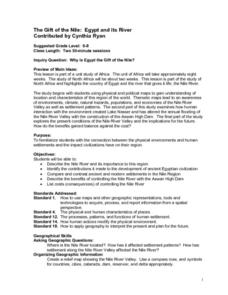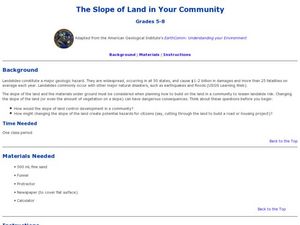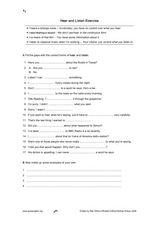Council for Economic Education
Cost/Benefit Analysis: Three Gorges Dam
Students, in groups, take various roles in evaluating the costs/benefits of the Three Gorges Dam project on the Yangtze River in China.
Curated OER
Shedding Light on Watersheds
Students discuss what a watershed is, complete online activities showing them how to take care of a watershed, and create a model of a watershed that they experiment with to see what happens when it is disrupted by civilization.
Curated OER
Cornplanter and the Fate of His Land
Students explore Chief Cornplanter and his importance as the leader of the Seneca tribe. In this Chief Cornplanter lesson, students examine how the Seneca land was taken over by the right of eminent domain. Students answer questions...
Curated OER
Global Climate Lesson Plans
Middle schoolers explore the concept of global climate. In this global climate lesson, students research and investigate global warming and its effects on the world over the course of 9 lessons. Middle schoolers create a proposal that...
Curated OER
The Gift of the Nile: Egypt and its River
Students begin with a piece of a puzzle that shows an artifact from ancient Egypt. They find others who have pieces that go with their puzzle piece. Students work in these groups to construct a relief map of the Nile River Valley.
Curated OER
Cartoons for the Classroom: An Educated Electorate Takes its Mid-Term
In this current events worksheet, students analyze a political cartoon about mid-term elections in the United States and respond to 3 talking point questions.
Curated OER
Environmental Health Hazards and Children
Students are introduced to the environmental hazards their community is facing. In groups, they develop a list of the ways humans have changed the Earth and how these changes have lead to environmental hazards. They record their...
Curated OER
Abolishing Slavery
Students explain the goals and methods of the abolitionist movement.
They identify key leaders in the movement. This lesson has adaptations for elementary through high school. Links are provided for resource readings.
Curated OER
Prairie Restoration and Prairie Ecology
Students collect data as they identify and classify native prairie plants and insects. They create their own population study using a variety of sampling techniques to determine the population density of various species. Students...
Curated OER
Animals, Soil, Trees
Fourth graders describe the various kinds of soils and how plants and animals are affected by them. They describe the baic needs of plants, scoring at least a 3 or 4 on a 4-point rubic. Students are able to predict and/or infer what...
Curated OER
Whose Water is It?
Students study water quality and water quantity issues in their community. They will examine state water laws, learn about current issues relating to water use and water scarcity in their region and the state, investigate and role play...
Curated OER
How Low Can You Go?
Fourth graders experience measuring temperatures after determining, by touch, whether water is hot or cold. They use a thermometers to measure the temperature of water in three cups of water. Using a vertical number line, they write the...
Curated OER
The Magic School Bus Kicks Up a Storm
Young scholars learn along with Ms. Frizzle's class. In this Magic School Bus lesson plan, students discover small updrafts by making wind spirals.
Curated OER
Environmental Problems and Solutions
In this environmental problems and solutions worksheet, students are given a list of 25 environmental problems. They match them with a given solution and paste the matching pairs to a piece of construction paper.
Curated OER
The Slope of Land in Your Community
Students participate in finding the slope of a sand pile and then other materials. In this geology lesson plan, students describe what happens to the piles of materials when they are poured through a funnel. Students measure the slope...
Curated OER
Effects of Bread Sanitary Conditions on Mold Growth
Students examine fungi and where it comes from. In this mold lesson students determine the percentage of fruit juice in a fruit then identify the different types of mold.
Curated OER
The Biggest Dam in the World
Students recognize that the Three Gorges Dam is now being constructed in China on the upper Yangtze River. They build a dam in an empty fish tankusing common materials they have at home or can easily find, such as twigs and leaves, food...
Curated OER
NCTA Lesson Plan on China
Young scholars identify China's geography, especially arable land, rainfall, crop growing areas, rivers, and mountains. Students select a technological advance to draw a diagram of the particular advance make transparencies of the...
Curated OER
Hear vs. Listen
In this English grammar worksheet, students differentiate between the usage of the words "hear" and "listen." Students complete 17 fill in the blank and 4 short answer questions using the correct word where appropriate.
Curated OER
How do rice farmers make good use of the land they use for planting rice?
Second graders discuss how farmers grow rice. In this rice growing lesson, 2nd graders see the optimal condition for land in order to grow rice. They experiment with clay and garden soil to see which holds water better.
Curated OER
Factors affecting infiltration and runoff
Students investigate some of the factors that determine the amount of runoff. They are reminded that infiltration and runoff tend to work oppositely. When conditions are bad for infiltration they usually lead to runoff.
Curated OER
How has rice been produced throughout history?
Fourth graders research rice history. In this rice history lesson, 4th graders discover the farming methods used to cultivate rice. They read about the role of rice in many cultures.
Curated OER
Let's Go To The Movies
Students explore technology used in making movies. In this movie making lesson, students investigate how technology has improved in the entertainment industry. Students discover how simple tools are combined together to make complex...
Curated OER
Your Amazing Brain
In these reading comprehension worksheets, 8th graders read a passage about the brain. Students then answer 5 reading comprehension questions about the text.

























